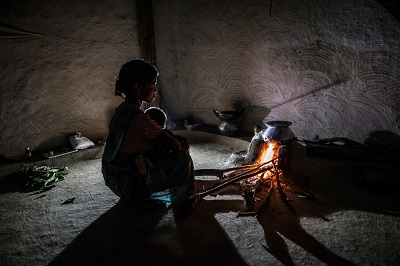Image: © UNICEF/UNI172848/Singh; Village Kuniya, Mainpat Block, Dist, Surguja, Chhattisgarh, India. 2013.
UNICEF urges immediate action to reduce air pollution amid emerging evidence on how toxic air can affect brain development in young children.
Danger in the Air: How air pollution can affect brain development in young childrennotes that breathing in particulate air pollution can damage brain tissue and undermine cognitive development – with lifelong implications and setbacks.
“Not only do pollutants harm babies’ developing lungs – they can permanently damage their developing brains – and, thus, their futures,” said UNICEF Executive Director Anthony Lake. “Protecting children from air pollution not only benefits children. It is also benefits their societies – realized in reduced health care costs, increased productivity and a safer, cleaner environment for everyone.”
Satellite imagery reveals that South Asia has the largest proportion of babies living in the worst-affected areas, with 12.2 million babies residing where outdoor air pollution exceeds six times international limits set by the World Health Organization. The East Asia and Pacific region is home to some 4.3 million babies living in areas that exceed six times the limit.
The paper shows that air pollution, like inadequate nutrition and stimulation, and exposure to violence during the critical first 1,000 days of life, can impact children’s early childhood development by affecting their growing brains:
• Ultrafine pollution particles are so small that they can enter the blood stream, travel to the brain, and damage the blood-brain barrier, which can cause neuro-inflammation.
• Some pollution particles, such as ultrafine magnetite, can enter the body through the olfactory nerve and the gut, and, due to their magnetic charge, create oxidative stress – which is known to cause neurodegenerative diseases.
• Other types of pollution particles, such as polycyclic aromatic hydrocarbons, can damage areas in the brain that are critical in helping neurons communicate, the foundation for children’s learning and development.
• A young child’s brain is especially vulnerable because it can be damaged by a smaller dosage of toxic chemicals, compared to an adult’s brain. Children are also highly vulnerable to air pollution because they breathe more rapidly and also because their physical defences and immunities are not fully developed.
The paper outlines urgent steps to reduce the impact of air pollution on babies’ growing brains, including immediate steps parents can take to reduce children’s exposure in the home to harmful fumes produced by tobacco products, cook stoves and heating fires:
• Reduce air pollution by investing in cleaner, renewable sources of energy to replace fossil fuel combustion; provide affordable access to public transport; increase green spaces in urban areas; and provide better waste management options to prevent open burning of harmful chemicals.
• Reduce children’s exposure to pollutants by making it feasible for children to travel during times of the day when air pollution is lower; provide appropriately fitting air filtration masks in extreme cases; and create smart urban planning so that major sources of pollution are not located near schools, clinics or hospitals.
• Improve children’s overall health to improve their resilience. This includes the prevention and treatment of pneumonia, as well as the promotion of exclusive breastfeeding and good nutrition.
• Improve knowledge and monitoring of air pollution. Reducing children’s exposure to pollutants and the sources of air pollution begins with understanding the quality of air they are breathing in the first place.
“No child should have to breathe dangerously polluted air – and no society can afford to ignore air pollution,” said Lake.
For additional information, read the paper here.
